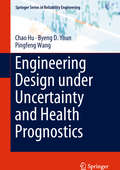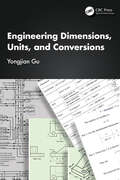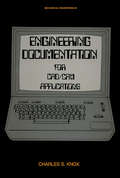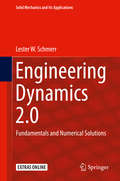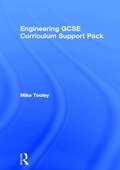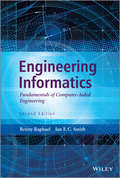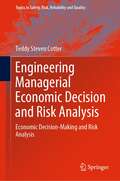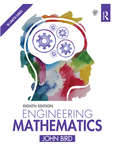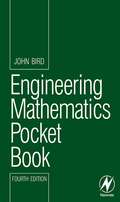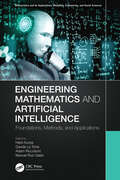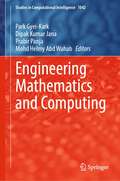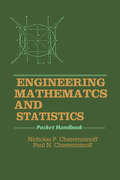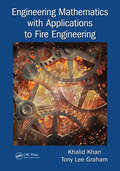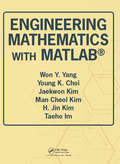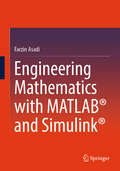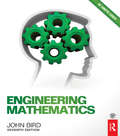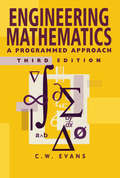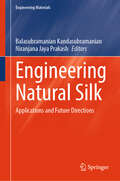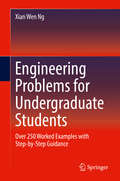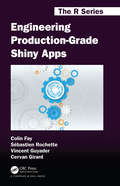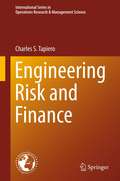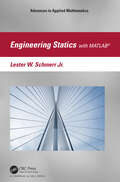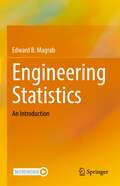- Table View
- List View
Engineering Design under Uncertainty and Health Prognostics (Springer Series in Reliability Engineering)
by Chao Hu Byeng D. Youn Pingfeng WangThis book presents state-of-the-art probabilistic methods for the reliability analysis and design of engineering products and processes. It seeks to facilitate practical application of probabilistic analysis and design by providing an authoritative, in-depth, and practical description of what probabilistic analysis and design is and how it can be implemented. The text is packed with many practical engineering examples (e.g., electric power transmission systems, aircraft power generating systems, and mechanical transmission systems) and exercise problems. It is an up-to-date, fully illustrated reference suitable for both undergraduate and graduate engineering students, researchers, and professional engineers who are interested in exploring the fundamentals, implementation, and applications of probabilistic analysis and design methods.
Engineering Dimensions, Units, and Conversions
by Yongjian GuEngineering Dimensions, Units, and Conversions delves into the analysis and application of the dimensions, units, and unit conversions in engineering practical use. It demonstrates the importance of dimensional homogeneity and unit consistency.Offering a comprehensive exploration of both primary and secondary units, the book presents detailed portrayals of various unit systems in both the English system and the International System (SI). It provides insight into conversion ratios and introduces software-based methodologies. The book also examines dimensioning in drawings, including dimensioning basics and numerous exercises of object and system dimensioning.The book will be a valuable reference for practicing engineers and researchers engaged in engineering research and development. It will also be of interest to undergraduate and graduate students in engineering disciplines.
Engineering Documentation for CAD/CAM Applications (Dekker Mechanical Engineering Ser. #30)
by Charles S. KnoxThis book emphasizes the importance of consistent, well-planned, and computer-oriented engineering documentation systems to engineering, manufacturing, and accounting. It discusses the systems needed to optimize flow of information and increase the efficiency of modern CAD/CAM systems.
Engineering Dynamics 2.0: Fundamentals and Numerical Solutions (Solid Mechanics and Its Applications #254)
by Lester W. SchmerrThis book presents a new approach to learning the dynamics of particles and rigid bodies at an intermediate to advanced level. There are three distinguishing features of this approach. First, the primary emphasis is to obtain the equations of motion of dynamical systems and to solve them numerically. As a consequence, most of the analytical exercises and homework found in traditional dynamics texts written at this level are replaced by MATLAB®-based simulations. Second, extensive use is made of matrices. Matrices are essential to define the important role that constraints have on the behavior of dynamical systems. Matrices are also key elements in many of the software tools that engineers use to solve more complex and practical dynamics problems, such as in the multi-body codes used for analyzing mechanical, aerospace, and biomechanics systems. The third and feature is the use of a combination of Newton-Euler and Lagrangian (analytical mechanics) treatments for solving dynamics problems. Rather than discussing these two treatments separately, Engineering Dynamics 2.0 uses a geometrical approach that ties these two treatments together, leading to a more transparent description of difficult concepts such as "virtual" displacements.Some important highlights of the book include: Extensive discussion of the role of constraints in formulating and solving dynamics problems.Implementation of a highly unified approach to dynamics in a simple context suitable for a second-level course.Descriptions of non-linear phenomena such as parametric resonances and chaotic behavior.A treatment of both dynamic and static stability.Overviews of the numerical methods (ordinary differential equation solvers, Newton-Raphson method) needed to solve dynamics problems.An introduction to the dynamics of deformable bodies and the use of finite difference and finite element methods.Engineering Dynamics 2.0 provides a unique, modern treatment of dynamics problems that is directly useful in advanced engineering applications. It is a valuable resource for undergraduate and graduate students and for practicing engineers.
Engineering Dynamics: A Basic Introduction
by Keith D. HjelmstadThis book provides an innovative approach to learning dynamics of particles and rigid bodies, emphasizing a consistent problem-solving framework designed to help students understand the subject while building and reinforcing the mathematical tools needed to bridge the gap between physical intuition and quantitative results. The theoretical developments are supported by an extensive set of MATLAB codes that give the reader powerful tools for exploring and visualizing basic concepts. The book is aimed at engineering students at the sophomore level who have a background in calculus, linear algebra, and differential equations. Uses clear and consistent derivations of the basic concepts of dynamics and provides an extensive set of MATLAB codes Embraces direct vector notation from the start and presents a consistent numerical framework for solving nonlinear differential equations Simplifies one of the most difficult aspects of dynamics—relative motion—using a novel approach to kinematics
Engineering GCSE Curriculum Support Pack
by Mike TooleyUsed alongside the textbook Engineering GCSE, this pack offers a complete course for the new GCSE syllabuses from Edexcel and OCR, providing all the resources needed by a busy teacher or lecturer as well as a student-centred learning programme that will enable students to gain the skills, knowledge and understanding they require.The photocopiable materials in this pack include:* Background to running a GCSE Engineering course* Worksheets to support and develop work in the textbook* Assignments, practicals and design briefs* Reference material and revision sheets for use as handoutsThis pack builds on the success of Mike Tooley's GNVQ materials, which have helped thousands of students to gain their first engineering qualification.Mike Tooley is Vice Principal at Brooklands College, Surrey, and author of many engineering and electronics books.
Engineering Informatics
by Benny Raphael Ian F. SmithComputers are ubiquitous throughout all life-cycle stages of engineering, from conceptual design to manufacturing maintenance, repair and replacement. It is essential for all engineers to be aware of the knowledge behind computer-based tools and techniques they are likely to encounter. The computational technology, which allows engineers to carry out design, modelling, visualisation, manufacturing, construction and management of products and infrastructure is known as Computer-Aided Engineering (CAE).Engineering Informatics: Fundamentals of Computer-Aided Engineering, 2nd Edition provides the foundation knowledge of computing that is essential for all engineers. This knowledge is independent of hardware and software characteristics and thus, it is expected to remain valid throughout an engineering career. This Second Edition is enhanced with treatment of new areas such as network science and the computational complexity of distributed systems.Key features: Provides extensive coverage of almost all aspects of Computer-Aided Engineering, outlining general concepts such as fundamental logic, definition of engineering tasks and computational complexityEvery chapter revised and expanded following more than ten years of experience teaching courses on the basis of the first editionCovers numerous representation frameworks and reasoning strategiesConsiders the benefits of increased computational power, parallel computing and cloud computingOffers many practical engineering examples and exercises, with lecture notes available for many of the topics/chapters from the ASCE Technical Council on Computing and Information Technology, Global Centre of Excellence in Computing (www.asceglobalcenter.org), providing a valuable resource for lecturers.Accompanied by a website hosting updates and solutionsEngineering Informatics: Fundamentals of Computer-Aided Engineering, 2nd Edition provides essential knowledge on computing theory in engineering contexts for students, researchers and practising engineers.
Engineering Managerial Economic Decision and Risk Analysis: Economic Decision-Making and Risk Analysis (Topics in Safety, Risk, Reliability and Quality #39)
by Teddy Steven CotterThis book directs the engineering manager or the undergraduate student preparing to become an engineering manager, who is or will become actively engaged in the management of economic-risk trade-off decisions for engineering investments within an organizational system. In today’s global economy, this may mean managing the economic risks of engineering investments across national boundaries in international organizations, government, or service organizations. As such, this is an applied book. The book’s goal is to provide an easy to understand, up to date, and coherent treatment of the management of the economic-risk trade-offs of engineering investments. This book accomplishes this goal by cumulatively sequencing knowledge content from foundational economic and accounting concepts to cost estimating to the traditional engineering economics knowledge culminating in fundamental engineering managerial economic decision-making incorporating risk into engineering management economic decisions.
Engineering Mathematics
by John BirdNow in its eighth edition, Engineering Mathematics is an established textbook that has helped thousands of students to succeed in their exams. John Bird's approach is based on worked examples and interactive problems. Mathematical theories are explained in a straightforward manner, being supported by practical engineering examples and applications in order to ensure that readers can relate theory to practice. The extensive and thorough topic coverage makes this an ideal text for a range of Level 2 and 3 engineering courses. This title is supported by a companion website with resources for both students and lecturers, including lists of essential formulae and multiple choice tests.
Engineering Mathematics Pocket Book
by John BirdThis compendium of essential formulae, definitions, tables and general information provides the mathematical information required by students, technicians, scientists and engineers in day-to-day engineering practice. A practical and versatile reference source, now in its fourth edition, the layout has been changed and the book has been streamlined to ensure the information is even more quickly and readily available - making it a handy companion on-site, in the office as well as for academic study. It also acts as a practical revision guide for those undertaking BTEC Nationals, Higher Nationals and NVQs, where engineering mathematics is an underpinning requirement of the course.All the essentials of engineering mathematics - from algebra, geometry and trigonometry to logic circuits, differential equations and probability - are covered, with clear and succinct explanations and illustrated with over 300 line drawings and 500 worked examples based in real-world application. The emphasis throughout the book is on providing the practical tools needed to solve mathematical problems quickly and efficiently in engineering contexts. John Bird’s presentation of this core material puts all the answers at your fingertips.
Engineering Mathematics and Artificial Intelligence: Foundations, Methods, and Applications (Mathematics and its Applications)
by Adam Riccoboni Herb Kunze Davide La Torre Manuel Ruiz GalánThe fields of Artificial Intelligence (AI) and Machine Learning (ML) have grown dramatically in recent years, with an increasingly impressive spectrum of successful applications. This book represents a key reference for anybody interested in the intersection between mathematics and AI/ML and provides an overview of the current research streams. Engineering Mathematics and Artificial Intelligence: Foundations, Methods, and Applications discusses the theory behind ML and shows how mathematics can be used in AI. The book illustrates how to improve existing algorithms by using advanced mathematics and offers cutting-edge AI technologies. The book goes on to discuss how ML can support mathematical modeling and how to simulate data by using artificial neural networks. Future integration between ML and complex mathematical techniques is also highlighted within the book. This book is written for researchers, practitioners, engineers, and AI consultants.
Engineering Mathematics and Computing (Studies in Computational Intelligence #1042)
by Dipak Kumar Jana Park Gyei-Kark Prabir Panja Mohd Helmy Abd WahabThis book contains select papers presented at the 3rd International Conference on Engineering Mathematics and Computing (ICEMC 2020), held at the Haldia Institute of Technology, Purba Midnapur, West Bengal, India, from 5–7 February 2020. The book discusses new developments and advances in the areas of neural networks, connectionist systems, genetic algorithms, evolutionary computation, artificial intelligence, cellular automata, self-organizing systems, soft computing, fuzzy systems, hybrid intelligent systems, etc. The book, containing 19 chapters, is useful to the researchers, scholars, and practising engineers as well as graduate students of engineering and applied sciences.
Engineering Mathematics and Statistics: Pocket Handbook
by Nicholas P. Cheremisinoff Louise FerranteThis pocket handbook is intended as a handy reference guide for engineers, scientists and students on widely used mathematical relationships, statistical formulas and problem-solving methods. It is a compilation of useful formulas and generalised problem-solving techniques employed by practitioners in the analysis and interpretation of scientific data and problem solving. Written in short note form, it is intended to provide the user with a quick, easy reference to information with ample references provided for further readings. Illustrated examples are included for more involved problem-solving methods. Many of the techniques are well suited to adaptatation on personal computers and there are more detailed instructions included to guide and illustrate computer aided problem solving.
Engineering Mathematics with Applications to Fire Engineering
by Khalid Khan Tony Lee GrahamThis book addresses direct application of mathematics to fire engineering problems <P><P> Gives background interpretation for included mathematical methods <P><P> Illustrates a step-by-step detailed solution to solving relevant problems <P><P> Includes pictorial representation of the problems <P><P> Discusses a comprehensive topic list in the realm of engineering mathematics topics including basic concepts of Algebra, Trigonometry and Statistics
Engineering Mathematics with MATLAB
by Won Y. Yang Young K. Choi Jaekwon Kim Man Cheol Kim H. Jin Kim Taeho ImThe aim of this book is to help the readers understand the concepts, techniques, terminologies, and equations appearing in the existing books on engineering mathematics using MATLAB. Using MATLAB for computation would be otherwise time consuming, tedious and error-prone. The readers are recommended to have some basic knowledge of MATLAB.
Engineering Mathematics with MATLAB® and Simulink®
by Farzin AsadiThis book summarizes the mathematics used by engineers, with an emphasis on developing practical skills and techniques for solving mathematical problems in forms typical of engineering. In addition to paper-and-pencil techniques, the book demonstrates how to solve engineering mathematics problems using state-of-the-art software packages. Specifically, it:• Offers a large collection of progressively more sophisticated mathematical problems.• Provides a brief review of definitions and formulas at the beginning of each topic.• Includes complete, tutorial-style solutions to all problems.• Presents step-by-step solutions using state-of-the-art MATLAB® and Simulink® tools.
Engineering Mathematics, 7th ed
by John BirdA practical introduction to the core mathematics required for engineering study and practice Now in its seventh edition, Engineering Mathematics is an established textbook that has helped thousands of students to succeed in their exams. John Bird's approach is based on worked examples and interactive problems. This makes it ideal for students from a wide range of academic backgrounds as the student can work through the material at their own pace. Mathematical theories are explained in a straightforward manner, being supported by practical engineering examples and applications in order to ensure that readers can relate theory to practice. The extensive and thorough topic coverage makes this an ideal text for a range of Level 2 and 3 engineering courses.This title is supported by a companion website with resources for both students and lecturers, including lists of essential formulae, multiple choice tests, full solutions for all 1,800 further questions contained within the practice exercises, and biographical information on the 24 famous mathematicians and engineers referenced throughout the book. The companion website for this title can be accessed from www.routledge.com/cw/bird
Engineering Mathematics: A Programmed Approach, 3th Edition
by C W. EvansThe programmed approach, established in the first two editions is maintained in the third and it provides a sound foundation from which the student can build a solid engineering understanding. This edition has been modified to reflect the changes in the syllabuses which students encounter before beginning undergraduate studies. The first two chapters include material that assumes the reader has little previous experience in maths. Written by CHarles Evans who lectures at the University of Portsmouth and has been teaching engineering and applied mathematics for more than 25 years. This text provides one of the essential tools for both undergraduate students and professional engineers.
Engineering Mechanics: Statics
by I. C. JongThis textbook and the following volume, Engineering Mechanics: Dynamics, are designed with a goal to provide students with a clear and thorough presentation of some well-understood basic principles and their application to the analysis of any problem in engineering mechanics in a concise and logical manner. It is hoped that this text will help instructors achieve this goal in their teaching of students in the first courses in statics and dynamics, which are in most cases offered in the sophomore or junior year in engineering curricula. In the development of the text, students are assumed to have certain basic background in algebra, geometry, trigonometry, and calculus. Nevertheless, a prior course in college physics normally enables students to attain a higher degree of readiness for learning the first courses in engineering mechanics.
Engineering Natural Silk: Applications and Future Directions (Engineering Materials)
by Balasubramanian Kandasubramanian Niranjana Jaya PrakashThis book highlights the potential of silk in a vast array of applications, mainly in the field of medicine, electronics, and cosmetics. The silk proteins are generally contrived within the specialized glands of the arthropods, viz silkworms, spiders, and moths posterior to the biosynthesis occurring inside the epithelial cells. The unique conformational orientation comprising of hydrophobic crystalline beta-sheet domains and hydrophilic amorphous random coil structure, their tunability, presence of plenteous functional groups, mechanical strength, ease of regeneration, biocompatibility and biodegradability has enabled silk to grow beyond textile materials over last few decades making it an excellent alternative to synthetic polymers.
Engineering Problems for Undergraduate Students: Over 250 Worked Examples with Step-by-Step Guidance
by Xian Wen NgThis textbook supplement deconstructs some of the most commonly-encountered and challenging problems arising within engineering domains such as thermodynamics, separation processes, chemical kinetics, fluid dynamics, and engineering mathematics that are foundational to most engineering programs, as well as many courses in STEM disciplines. The book is organized into a series of 250 problems and worked solutions, with problems written in a format typical of exam questions. The book provides students ample practice in solving problems and sharpening their skill applying abstract theoretical concepts to solving exam problems. The presentation of detailed step-by-step explanations for each problem from start to finish in this book helps students follow the train of thought toward arriving at the final numerical solutions to the problems.Stands as an all-in-one, multidisciplinary, engineering problem-solving resource with comprehensive depth and breadth of coverage;Adopts a highly relevant question and answer pedagogy;Maximizes understanding through clear use of visuals;Emphasizes detailed, step-by-step explanations;Includes supplementary sections of cross-referenced concepts.
Engineering Production-Grade Shiny Apps (Chapman & Hall/CRC The R Series)
by Colin Fay Sébastien Rochette Vincent Guyader Cervan GirardFrom the Reviews "[This book] contains an excellent blend of both Shiny-specific topics … and practical advice from software development that fits in nicely with Shiny apps. You will find many nuggets of wisdom sprinkled throughout these chapters…." Eric Nantz, Host of the R-Podcast and the Shiny Developer Series (from the Foreword) "[This] book is a gradual and pleasant invitation to the production-ready shiny apps world. It …exposes a comprehensive and robust workflow powered by the {golem} package. [It] fills the not yet covered gap between shiny app development and deployment in such a thrilling way that it may be read in one sitting…. In the industry world, where processes robustness is a key toward productivity, this book will indubitably have a tremendous impact." David Granjon, Sr. Expert Data Science, Novartis Presented in full color, Engineering Production-Grade Shiny Apps helps people build production-grade shiny applications, by providing advice, tools, and a methodology to work on web applications with R. This book starts with an overview of the challenges which arise from any big web application project: organizing work, thinking about the user interface, the challenges of teamwork and the production environment. Then, it moves to a step-by-step methodology that goes from the idea to the end application. Each part of this process will cover in detail a series of tools and methods to use while building production-ready shiny applications. Finally, the book will end with a series of approaches and advice about optimizations for production. Features Focused on practical matters: This book does not cover Shiny concepts, but practical tools and methodologies to use for production. Based on experience: This book is a formalization of several years of experience building Shiny applications. Original content: This book presents new methodologies and tooling, not just a review of what already exists. Engineering Production-Grade Shiny Apps covers medium to advanced content about Shiny, so it will help people that are already familiar with building apps with Shiny, and who want to go one step further.
Engineering Risk and Finance
by Charles S. TapieroRisk models are models of uncertainty, engineered for some purposes. They are "educated guesses and hypotheses" assessed and valued in terms of well-defined future states and their consequences. They are engineered to predict, to manage countable and accountable futures and to provide a frame of reference within which we may believe that "uncertainty is tamed". Quantitative-statistical tools are used to reconcile our information, experience and other knowledge with hypotheses that both serve as the foundation of risk models and also value and price risk. Risk models are therefore common to most professions, each with its own methods and techniques based on their needs, experience and a wisdom accrued over long periods of time. This book provides a broad and interdisciplinary foundation to engineering risks and to their financial valuation and pricing. Risk models applied in industry and business, heath care, safety, the environment and regulation are used to highlight their variety while financial valuation techniques are used to assess their financial consequences. This book is technically accessible to all readers and students with a basic background in probability and statistics (with 3 chapters devoted to introduce their elements). Principles of risk measurement, valuation and financial pricing as well as the economics of uncertainty are outlined in 5 chapters with numerous examples and applications. New results, extending classical models such as the CCAPM are presented providing insights to assess the risks and their price in an interconnected, dependent and strategic economic environment. In an environment departing from the fundamental assumptions we make regarding financial markets, the book provides a strategic/game-like approach to assess the risk and the opportunities that such an environment implies. To control these risks, a strategic-control approach is developed that recognizes that many risks resulting by "what we do" as well as "what others do". In particular we address the strategic and statistical control of compliance in large financial institutions confronted increasingly with a complex and far more extensive regulation.
Engineering Statics with MATLAB® (ISSN)
by Lester W. Schmerr Jr.This text makes use of symbolic algebra and vector-matrix algebra to demonstrate a new approach to learning statics. Symbolic solutions are obtained, together with the types of solutions covered in other texts, so that students can see the advantages of this new approach.This innovative text is an extension of second-generation vector Statics courses to a new, third-generation matrix-vector Statics course, a course that addresses deformable as well as rigid bodies and employs MATLAB®.MATLAB® is used as a “calculator” whose built-in functions are used to solve statics problems. This text uses vectors and matrices to solve both statically determinate rigid body problems and statically indeterminate problems for deformable bodies.The inclusion of statically indeterminate problems is unique to this text. It is made possible by using symbolic algebra and a new, simplified vector-matrix formulation that combines the equations of equilibrium, the homogeneous solutions to those equations, and a description of the flexibilities found in the deformable elements of a structure to solve directly for the unknown forces/moments.
Engineering Statistics: An Introduction
by Edward B. MagrabThis book presents a concise and focused introduction to engineering statistics, emphasizing topics and concepts that a practicing engineer is mostly likely to use: the display of data, confidence intervals, hypothesis testing, fitting straight lines to data, and designing experiments to find the impact of process changes on a system or its output. It introduces the language of statistics, derives equations with sufficient detail so that there is no mystery as to how they came about, makes extensive use of tables to collect and summarize important formulas and concepts, and utilizes enhanced graphics that are packed with visual information to illustrate the meaning of the equations and their usage. The book can be used as an introduction to the subject, to refresh one’s knowledge of engineering statistics, to complement course materials, as a study guide, and to provide a resource in laboratories where data acquisition and analysis are performed.Created specifically for the book are 16 interactive graphics (IGs) that can be used to replicate all numerical calculations appearing in the book and many of its figures, numerically evaluate all formulas appearing in tables, solve all exercises, and determine probabilities and critical values for commonly used probability distributions. After downloading a free program, the IGs are ready to use and are self-explanatory in the context of the material.
